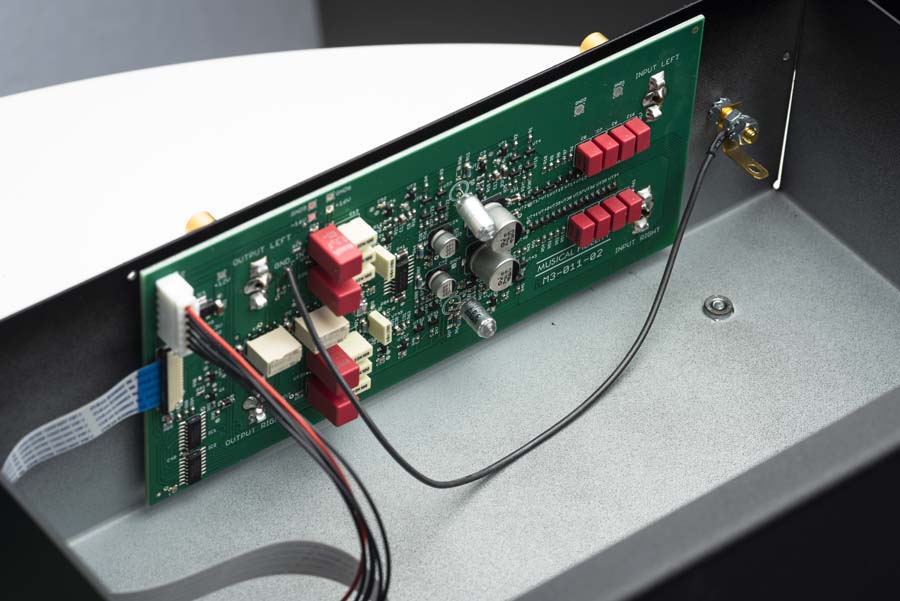MUSICAL FIDELITY M3X VINYL PHONOSTAGE REVIEW
Musical Fidelity is a well known and well-respected brand that is distributed in the UK. In this review, Stuart Smith takes a listen to their £1200 M3X Vinyl phonostage.

Simple, clean, and well laid out front panel.
I have a bit of a soft spot for Musical Fidelity as my first ever proper bit of HiFi kit was a second hand Musical Fidelity The Preamp. I absolutely loved it partnered with a Crimson Electric power amplifier and some Wharfedale Diamond loudspeakers and it was my first taster of something that was to become something of an obsession. It was a simple, no-nonsense affair but boasted both moving magnet and moving coil inputs, though at the time moving coil cartridges were the stuff of dreams.
Jump forward thirty-odd years and I’m still obsessed with music and the kit that we use in the home to play it back on, and I’m very pleased to say that Musical Fidelity seems to have been a constant feature in the audio world throughout that time, though the only other piece of their equipment I have actually owned was the rather excellent Nu Vista CD Player which I regret selling to this day. I do think Musical Fidelity lost their way a touch at one point and there never seemed to be a season go by where they weren’t releasing a new amp that featured more power than the last. I’m glad to report that it seems the brand has calmed down somewhat in this respect, though their range of products is pretty extensive – for example, the company does have six phonostages in its portfolio with the product we have here, the M£X Vinyl falling somewhere in the middle of the range and costing about €1300 or £1200 at the time of writing.
MUSICAL FIDELITY M3X VINYL FEATURES AND BUILD
The version we have been sent to review is a rather nice looking matt black (also available in silver) colour that is full width and full depth. I like this as it immediately feels like it is a proper piece of HiFi when sat on the rack. It’s a phonostage that does both MM and MC, but being a phonostage it was never going to be brimming with dials and knobs, though thankfully it has done away with those infernal DIP switches that I find so damned fiddly and instead gives us proper push buttons that are front-mounted by which to alter parameters. This is an immediate feather in the M3X’s cap.
Feature-wise on the front panel you have the discrete logo on the top left and then a series of six small silver buttons and blue LEDs, thankfully the latter are not of the variety designed to confuse passing overhead aircraft and are nice and subdued.
These buttons from left to right are: Power/Standby/Mute, MM/MC, MM loading, an IEC button (a button that activates a circuit that is designed to cut the subsonic output of the phonostage that is caused by warped records and whilst I have no idea what IEC stands for I’m assuming it is acting as what I have up until now known as a rumble filter), +/-6dB Gain, and the MC loading. The MM loading (50, 100, 200, 300, 350, and 400pF) and MC loading (25R, 50R, 100R, 400R, 800R, and 1K2) have LEDs to indicate your selection. The technical data at the bottom of this review will give those interested more information.
Round the back there’s nothing out of the ordinary with a grounding post, a pair of RCA inputs, a pair of RCA outputs, and the IEC input for the juice.
The accompanying handbook for the M3X VINYL talks about it using only discrete circuitry claiming a better measured and subjective sound. Basically, there are no OP-Amps used in the unit with Musical Fidelity claiming this leads to a better sound, despite a more complex process of putting the thing together.
All in all this unit seems to offer a comprehensive range of inputs that should be more than ample for most users looking at spending this kind of money and it is in keeping with what the competition offer by way of features. What I do like is that there is easy switching from the front panel and the provision for both moving magnet and moving coil cartridges in one box. There’s a current thing for phonostages (though we are getting into more expensive esoteric territory) to offer equalisation curves other than RIAA, but at this kind of price RIAA only is perfectly normal and acceptable and I mention only to point out that they are available to those with extensive collections of older records that don’t conform to the RIAA standard.
Critics are going to say that the amount of space inside the box represents poor value but lets not forget that this unit has an onboard power supply built into the unit and not one of the wallwarts that seem to be the norm, and this space allows a good degree of isolation of it from the sensitive electronics. Anyway, it makes the stage proper HiFi size and I like that.

Inside the M3X showing the onboard power supply.

The main electronics are shielded from the PSU.
MUSICAL FIDELITY M3X VINYL SOUND
For the purposes of this review, I used the Technics 1200G with a Sumiko Olympia moving magnet cartridge (£225) and a GoldNote Tuscany Red moving coil cartridge (£4700). The latter is a bit over the top with regards to price points but it’s the cartridge I use most of all on this turntable and so I know it pretty well.
I’ve said this before, but for me, a phonostage needs to be quiet in itself, add little flavour of its own, and follow the RIAA curve faithfully. I don’t use measurement and so I’m assuming that Musical Fidelity, and all other phonostage manufacturers for that matter, have ensured that the M3X follows the curve faithfully.
Playing the half-speed master of John Martyn’s Solid Air with the Sumiko there is very little to complain about at all. Contrabass is solid and suitably real sounding and overall there’s a balanced feeling to the sound I’m hearing. In comparison to our LAB 12 melto phono and on moving magnet I’d say the melto gives me a better feeling for the smaller details I’m listening for during a review session, but in truth would likely miss during normal listening sessions. Instrument separation is very good and there is a very reasonable soundstage thrown with a slightly forward sound. All in all with the Sumiko in place I reckon I’m hearing the cartridge and its characteristics over and above anything the M3X is adding to the equation. If anything I would suggest that the extreme top end is a little muted leading to a less “sparkly” presentation. This latter point may suggest that there is a lack of upper-end detail, and it is slightly rolled off at the extremes, but this actually makes for a less taxing listen overall.
Switching to the Tuscany Red moving coil and playing the same record it’s immediately clear that the MX3 allows the better cartridge to shine out as being head and shoulders more revealing and detailed than the Sumiko – had it not done this then there’d have been something to worry about. Again, what I believe I am hearing is much more of the character of the cartridge than that of the phonostage itself, and let’s face it, this is what you want to be hearing. Hitting the +6dB button has little effect but make the whole thing louder, but will be useful if you have very low output cartridges. Again, I would say the more costly melto has it on sound quality overall and presents a wider, higher and deeper soundstage and a more extended top-end performance.

Plenty of room around the back.
Playing another of our reference albums, Daft Punk’s Random Access Memories, it’s clear that the M3X isn’t doing a whole lot of masking of what the cartridge is digging out of the grooves and in that sense it’s a pretty accurate portrayal of what’s on a record. Yes, it’s not perfect and, as mentioned, I feel the top end is a little closed in but then bass is tight and properly presented as demonstrated throughout this record. Tiny details such as the layering of sounds that go to make up the synth noises in Contact aren’t as apparent as with the melto but, again, you have to be listening critically for this to be apparent. There is still excitement and a sense of listening to the cartridge rather than the phonostage – and this is a good thing. The sense of “realism” is pretty good throughout this record but one thing I did pick up on with the Tuscany in place was that the click that is used at the end of Moroder’s speech at the start of Giorgio didn’t have the same sense of “clickiness” as with the other phonostage in this system, and by this I mean it didn’t have that snappiness to it that I’m used to. However, overall, the phonostage is well accomplished dynamically speaking. I would also suggest that on busier passages the Musical Fidelity is a little muddled in comparison, but it is on a par with the Slee phonos we have here and to hand. Spatially the Musical Fidelity is very good too without over-exaggeration or a feeling of artifice which in turn leads to a nice and natural/organic listening experience.
I could go on and talk about all the different records I played switching between the two cartridges but I reckon that would be a waste of time as I think the couple of paragraphs or so above make it pretty clear that the M3X is fairly transparent in its converting the tiny voltages from the cartridge into something the preamp proper can make use of.
I don’t have a lot of warped records as they either go back if new or not bought if they are secondhand. As such the IEC/Rumble button wasn’t really needed for me but pressing it on normal records had the (expected) effect of making them sound a little dull and muted in the bottom end. If you do buy a lot of secondhand records or aren’t particularly meticulous in the storage of your vinyl then it may well be of use to you and it’s good to see its inclusion here.

Also available in silver.
CONCLUSION
This is an accomplished and enjoyable product that does what it is supposed to at the price point – it allows the cartridge you use to reveal its own character without adding too much of the character of the electronics inside the M3X itself.
I would suggest that if we are being hyper critical (we are) the extreme top-end is slightly rolled off leading to what many will find to be a less taxing and more comfortable listening experience. Personally, I found this a little sonically confining and less open when compared to the more expensive unit I compared it to. However, it performs on a par with the phonos we have to hand and with regards to its looks and form-factor would seem to offer more bang for your buck.
The M3X has good looks, has a reasonable amount of flexibility with regards to loading, and the IEC/Rumble filter will be useful for some – as will the +6dB button.
The top and bottom of this phonostage is that there is very little to whine about and lots to commend.
AT A GLANCE
Build and Features:
Plenty of options for loading
Provision for MC and MM
Nice looking proper sized box that is well finished
Onboard rumble filter
Sound Quality:
Allows the cartridge to show its own character
Slightly rolled off at the very extremes of the top end – most noticeable on MCs
Quiet
Organic sounding with an overall lack of artifice
Value For Money:
I reckon this is pitched at the right price and represents good value for money given the sonics and the features on hand
We Loved:
Lovely looking and well finished
Enough parameters to satisfy all but the most hardened vinylista
Great sounding
We Didn’t Love So Much:
Not absolutely transparent in comparison to our costlier phonostages
Price: €1300. £1200
Elevator Pitch Review: The M3X from Musical Fidelity is a very good looking unit that feels and looks like a quality product. It offers reasonable options with regards to loading for both Moving Coil and Moving Magnet cartridges and to a large degree allows your choice of cartridge to shine out. I found it a little less open in the top end but other than that it’s a very good phonostage for the very reasonable asking price.
Technical Data
Frequency response: MM: RIAA or RIAA/IEC ±0 .2dB. MC: RIAA or RIAA/IEC ±0.3dB
Input Sensitivity: MM: 5mV in for 500mV out (at 1 kHz). MC: 500μV in for 500mV out (at 1 kHz)
Input Impedance: MM: 47KΩ. MC: 25Ω to 1,2KΩ selectable
Input Capacitance: MM: 50-400pF selectable
Gain: MM: 40 or 46dB with +6dB function. MC: 60 or 66dB with +6dB function
THD+N: MC: <0.28%
Signal to noise ration: MM: 71dB. MC: 59dB
Crosstalk: MM: better than 100dB . C: better than 90dB
Output: 1 pair RCA: left and right 500mV nom 10V max
Input:1 pair RCA
Power Requirement: Mains voltages: 230V/115V; AC 50/60Hz
Consumption: 20 Watts maximum. 0W in standby)
Weight and Dimensions: Unit only, unboxed: 6.59 kg. W x H(incl. feet) x D(incl. terminals): 440 x 105 x390mm
Standard Accessories: Mains lead: 10 Amp IEC








































































































































































